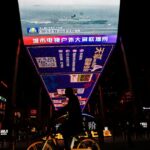|

Who is Jay Lynn Gomez? That question animates the artist’s current exhibition at P.P.O.W in New York, and the answer is a bit complicated, ever evolving. Titled “Under Construction” and on view through June 15, the show poignantly and earnestly depicts Gomez’s gender transition—a process encumbered by the fact that Gomez had already achieved some art-world acclaim using her former name, having exhibited in major group shows like “¡Printing the Revolution! The Rise and Impact of Chicano Graphics, 1965 to Now” at the Smithsonian American Art Museum and “Day Jobs” at the Blanton Museum of Art.
In 30 some paintings and mixed-media works, many of them self-portraits, we see Gomez contending with her new life. We see her newly subject to the leering gaze of construction workers, and getting accosted by a white woman for using the women’s bathroom at Fenway Park. Elsewhere, in one of the show’s best works, a 2024 canvas titled I am a work in progress, we see Gomez as her former male self, painting a vision of a woman of her own making, as she now wants to be seen. Next to her palette and brushes, we see her gender-affirming medications. Behind him a woman, the artist’s mother, dusts off one of Gomez’s earlier works.
Earlier this year, the artist began painting scenes from her transition directly onto her hormone packaging. The earliest work from this series is titled shot day (all works 2024); it is a tender self-portrait showing the artist injecting her abdomen with hormones. The piece, measuring just over 3 by 6 inches, is painted directly onto the flattened box of Gomez’s Estradiol valerate , her legal name partially visible. This work joins about a dozen other small drawings of Gomez at various stages in her life, all painted on her hormone packaging. This use of found cardboard recalls an earlier series, begun in 2013, in which Gomez painted Latinx domestic workers—gardeners tending to manicured lawns, pool cleaners fishing for leaves—onto magazine pages displaying beautiful mansions that they keep pristine; Gomez later scaled these drawings up to David Hockney-esque paintings. Her objective then as now is to show those who have been marginalized or rendered invisible.
In “Under Construction,” she gives her own process of transitioning a rare kind of visibility, carving an ideal image of herself while also grappling with how the world sees her. But she doesn’t stop there: she also honors the enormous contributions that trans women of color have made toward civil rights for queer people. These women have often been, until recently, intentionally erased from history; Gomez pays homage to some in a monumental work titled Trans women of color that includes Sylvia Rivera, Cecilia Gentili, and Erotica Divine.
But visibility has its downsides. Gomez confronts them in Every day I walk outside is a leap of Faith (Walking with Alok), which shows the artist in a black bra, staring in the mirror as she shaves her upper lip. Behind her, a canary flies out of a gold cage, and in one corner Gomez has kissed the canvas with a pair of a bright-red lips. In the foreground is Alok, a gender non-conforming poet and comedian who has been a mentor to Gomez during her transition. The two are surrounded by leering construction workers and signs reading ROAD CLOSED and DETOUR. There’s tension in this scene: like the overlooked laborers in their high visibility orange, Gomez and Alok appear both hyper-visible, and yet invisible, too.
That painting is untethered to any real space: instead, the figures float in a purple void. Gomez uses purples often, perhaps referencing the swirling together of the colors of the trans flag (pink, cyan, and white), or even the spectrum of hues in a bruise: a bruise at the site of hormone injection; a bruise from hemophilia, a condition Gomez has; a bruise that refers to the violence that trans women of color often face, whether from lovers, from johns, or even from catcalling construction workers.
At the back of the exhibition, there is a sculptural intervention. There, Gomez has installed a chain-link fence covered by a green tarp, with diagrams of her facial feminization and breast augmentation surgeries painted onto the surface. Surrounding these diagrams are outlines of butterflies: the ultimate symbol of transformation. A sign on the floor warns: “WERK ZONE.” Nearby, Gomez has dedicated a poem to his friend Winter Camilla Rose—also depicted in a leisurely odalisque portrait—about “a journey with no guide / with no end.”
Caption: Ramiro Gomez, I am a work in progress, 2024. Photo: JSP Art Photography/Courtesy the artist and P·P·O·W, New York
|





